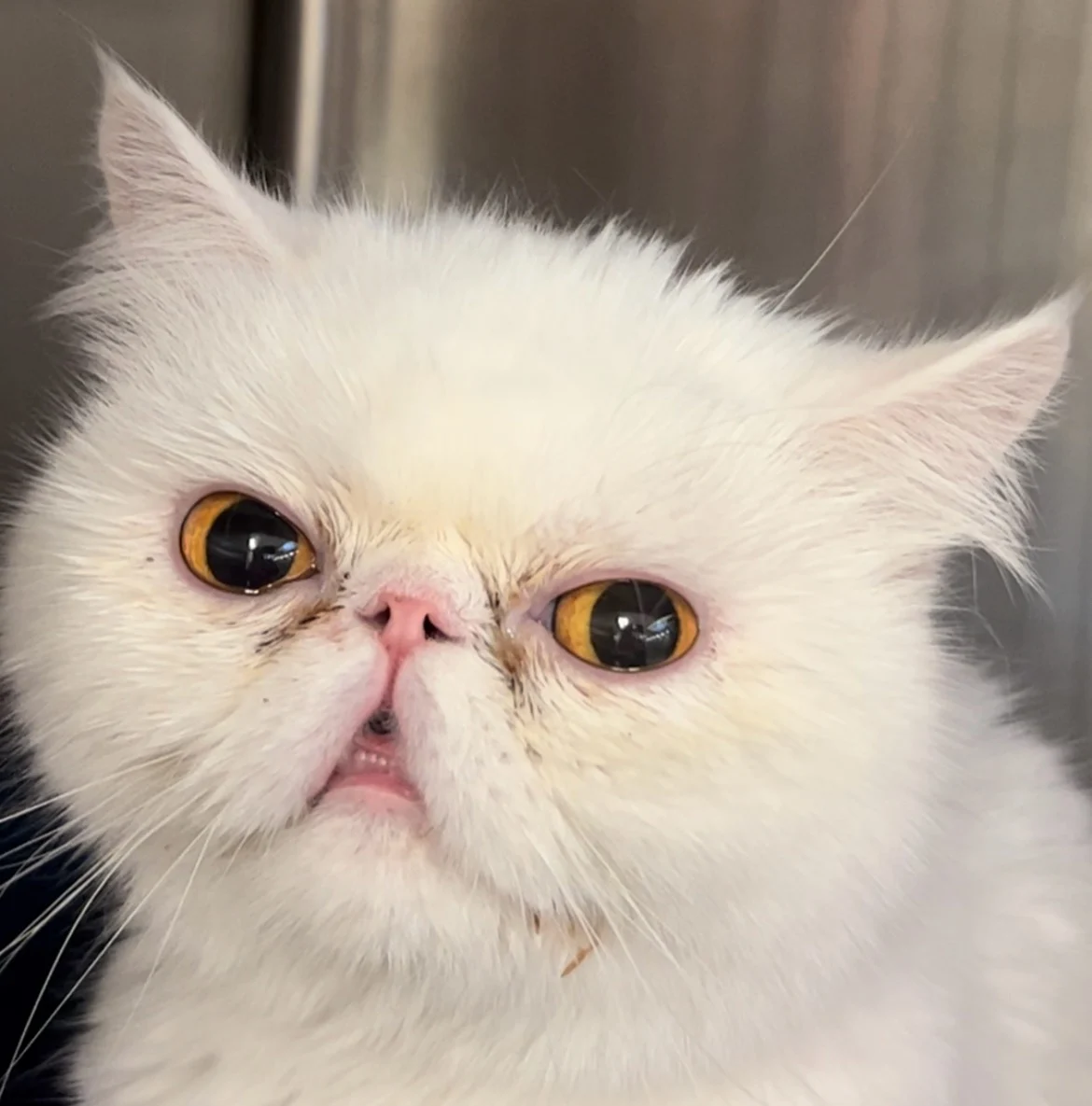The normal respiratory rate of cats in the home is ≤30 breaths per minute.1 Respiratory rate in clinic examination rooms is commonly higher (median, 64 breaths per minute).2 Tachypnea is defined as a respiratory rate higher than normal. Panting is a form of tachypnea defined as an increased respiratory rate with short and shallow breaths and may be normal or part of respiratory distress.
Myth: Panting in Cats Always Indicates a Significant Concern
Clinical Reality of Panting in Cats
Cats are preferential nasal breathers but not obligate nasal breathers like horses and rabbits. Clinical panting is less frequently associated with overheating in cats compared with dogs; however, panting is normal in cats in a hot or stressful environment or following rough play, particularly in kittens.
Distinguishing between panting and open-mouthed breathing can be a challenge (Figure).

Panting in a brachycephalic cat. The nose and mucous membranes are relatively pink.
The panting respiratory rate to facilitate cooling in dogs is ≈300 breaths per minute, which is 10 times the normal rate. This elevated rate is considered the resonant frequency of the respiratory system, meaning panting does not result in a net gain of heat, which would negate the cooling effect of panting.3 Panting in cats serves a similar purpose and also does not result in a net gain of heat. The ventilatory strategy used in panting has been mimicked by high-frequency jet ventilation,4 a technique used most commonly in critically ill premature infants with severe lung disease, in which the ventilatory rate is 400 to 600 breaths per minute with very small tidal volumes.
What to Do When a Cat Is Presented With Panting
Panting should be evaluated in the context of patient age, history, and physical examination findings. When there is concern for difficulty breathing, initial examination should focus on major body systems to identify any urgent stabilization needs. Pet owners may be unaware of signs of respiratory distress and present cats for more vague signs (eg, anorexia, lethargy); in these cases, cardiopulmonary disease may be detected on examination.
Common Clinical Scenarios of Panting in Cats & Appropriate Responses
In a kitten panting after exercise, auscultation should be performed to identify abnormalities. If none are heard, no further action is required.
In an adult cat panting after a stressful event or overheating, the patient should be allowed to calm down. If the patient started panting on the way to the clinic, has a pink nose and mucous membranes, and is not in apparent distress, allowing time to rest in a cage or examination room with the owner should result in rapid resolution. Premedication with gabapentin may decrease anxiety for future visits to the clinic.5 If the patient is postanesthesia or receiving opioids, rectal temperature should be taken to evaluate for overheating. Auscultation should be performed and medical history reviewed. If results are normal, the initial diagnostic and therapeutic plan can be continued.
In a cat that is open-mouthed breathing, ruling out lung disease (eg, pulmonary edema, pleural effusion) via point-of-care ultrasonography or thoracic radiography is essential. If findings are normal, nasal obstruction (eg, upper respiratory infection, mass, polyp) should be considered. Some cats with nasal or laryngeal obstruction may be aerophagic, and a gas-filled esophagus due to airway obstruction can be mistaken for a megaesophagus.
In a cat panting with labored breathing, a complete evaluation should be performed, including assessment for metabolic acidosis (eg, renal failure, diabetic ketoacidosis) and pulmonary infiltrates (eg, congestive heart failure, asthma). If the cat appears distressed, breathing is labored, or abnormal lung or heart sounds are heard, it is appropriate to continue evaluation for cardiopulmonary disease, possibly including thoracic radiography or point-of-care ultrasonography, N-terminal pro-B-type natriuretic peptide (NT-proBNP), heartworm testing, and/or more advanced diagnostics (eg, echocardiography, tracheal wash, thoracocentesis, upper airway examination) as clinically indicated and acceptable to the owner.6
Identifying True Respiratory Distress in Cats
True respiratory distress due to decreased compliance of the lungs increases the work of breathing, generates heat, and burns calories.
Panting in hot or stressed cats is usually not a sign of distress; however, distinguishing panting as an effort to cool or due to obstructed nasal flow from increased respiratory effort associated with parenchymal lung disease or pleural space disease may be difficult. Respiratory distress, especially distress caused by lung disease, is frequently associated with tachypnea. Cats that are tachypneic due to respiratory disease typically have a respiratory rate of <100 breaths per minute, compared with 300 breaths per minute observed with panting. In addition, cats with respiratory distress appear to maintain their focus on the effort of breathing and are typically relatively tolerant of gentle handling, whereas cats with panting from stress are more likely to demonstrate efforts to escape and resistance to handling.
Home Monitoring of Respiratory Signs in Cats
If respiratory signs are intermittent, having the owner record a video of the signs is often useful. In addition, owners can be instructed to routinely monitor resting respiratory rate, even in apparently healthy cats, as elevated respiratory rate (>30 breaths per minute) while sleeping has been associated with heart disease.1 The author views resting respiratory rate observation as a general home health guide, similar to monitoring for weight gain or loss and checking monthly for evidence of skin concerns, lumps, vomiting, diarrhea, and altered appetite.